Comparison of Power Usage of Programming Languages
Elias Stenhede Johansson, Gustav Leth-Espensen, Florian Ecker-Eckhofen, Gustav Emil Nobert.
abstract Lorem ipsum dolor sit amet, consectetur adipisicing elit, sed do eiusmod tempor incididunt ut labore et dolore magna aliqua. Ut enim ad minim veniam, quis nostrud exercitation ullamco laboris nisi ut aliquip ex ea commodo consequat. Duis aute irure dolor in reprehenderit in voluptate velit esse cillum dolore eu fugiat nulla pariatur. Excepteur sint occaecat cupidatat non proident, sunt in culpa qui officia deserunt mollit anim id est laborum.
Introduction
Nowadays, software is an important part of everyone’s life. Software is used to communicate, work, entertain and even to control devices in ones home. However, software requires energy to operate, and with the increasing demand for digital services, energy consumption has become a significant concern. Energy consumption not only affects the environment by contributing to carbon emissions but also impacts the operational cost of businesses and the performance of devices. By the year 2040, the contribution of the sector for information and communication technologies to global carbon emissions will rise up to 14%. Therefore, it is important to measure the energy consumption of software to optimize energy efficiency, reduce carbon footprint, and enhance the performance of devices. Measuring the energy consumption of software helps developers and businesses to identify energy-hungry processes and optimize them, thereby improving the overall energy efficiency of their products. In this context, sustainable software engineering has become a critical aspect of sustainability, and measuring the energy consumption of software is a fundamental step towards achieving that purpose. The decision of what programming language to use is one of the most fundamental questions when working in the information and communication industry and has a huge impact on the future energy consumption of software programs. Usually the main factors in choosing a language is running speed and competences of the developers. However with the increase in interest in sustainable software we want energy consumption to be a factor when choosing language. Therefore, the goal of our report is to highlight differences in energy consumption, depending on the used programming language and to answer the following research questions:
-
RQ1. How does the energy consumption of each programming language compare?
-
RQ2. How does the energy consumption on average differ inside each programming language?
For the purpose of answering the research questions, we made an experiment to measure the energy consumption of different programming languages (C, Matlab, Python) while solving a mathematical calculation. In the second chapter of this paper, the setup of the experiment is displayed. In the third chapter the results of the experiments will be visualized and the research questions will be answered. In Conclusion, in the forth and last chapter, the results will be discussed and compared with the results of the study "What Are Your Programming Language’s Energy-Delay Implications?".
Our comparison
The benchmark
The code we are benchmarking computes the number of pairs of points that are intersecting (defined as closer than 5 cm to each other), which might be one step in a larger program. The position data is taken from one random time step of a simulation of gravel sliding down a conveyor belt.
The benchmark we use for our study consists of the following steps:
-
Parse a file consisting of approximately 16000 rows, where each row corresponds to the x, y and z coordinates of a point.
-
Sort the points by x coordinate, to reduce the number of comparisons in a later step.
-
Initialize a counter.
-
For every point, compare it with all the points with a x coordinate larger than its own, since the points are sorted, we can stop comparing when the difference between x coordinates is larger than 5 cm. If the point is close enough, increment the counter.
-
Print out the number of pairs of points intersecting.
The distribution of the points before and after sorting can be seen in [fig:pre]{reference-type=”ref” reference=”fig:pre”} and 2{reference-type=”ref” reference=”fig:post”}.
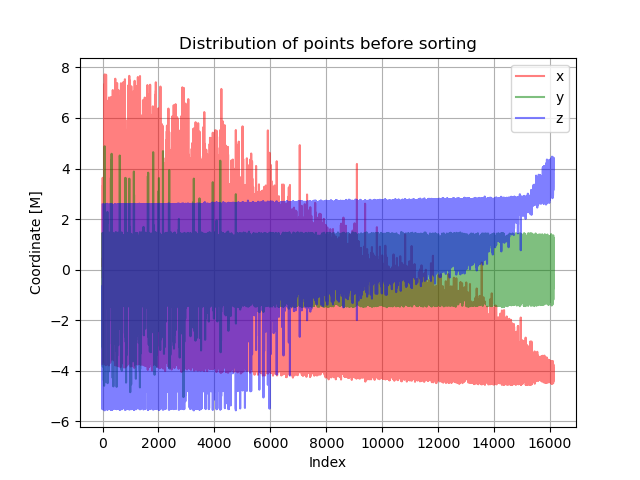 {#fig:post}
{#fig:post}
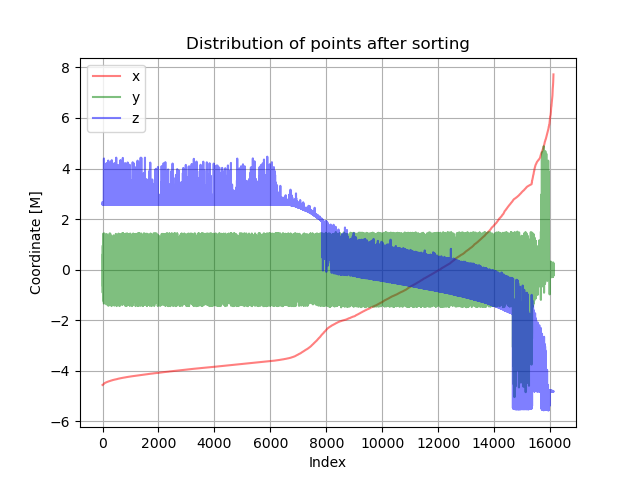 {#fig:post}
{#fig:post}
Running the code
The code was implemented in three languages, namely C, Python and Matlab. The C code was compiled with the flag -O3, the Python code was run with version 3.11 and the Matlab code with MATLAB R2022a. It was then run on three different laptops and the energy consumption was benchmarked 30 times using the Intel Power Gadget.
Prevention of confounding factors
When making a scientific experiment on energy consumption it is important to prevent confounding factors that could interfere with the results of the experiment. For that matter, all the experiments used different laptops but the same setup:
-
All applications were closed
-
All notifications were turned off
-
All unnecessary services like web servers were killed in advance
-
The brightness of the screen was turned to minimum
-
All the laptops had the internet connection turned off
-
All the laptops were connected to the charger
Energy consumption is highly affected by the temperature of the hardware that is used. To prevent that the first execution will appear more efficient than the following, all devices had to run a CPU-intensive task before running the experiment and measuring the energy consumption. In addition, for the validation of the results, every language had to run the same calculation 30 times. At the end, the results of the measurements were collected and are visualized in the following chapter.
 []{#fig:pre label=”fig:pre”}
[]{#fig:pre label=”fig:pre”}
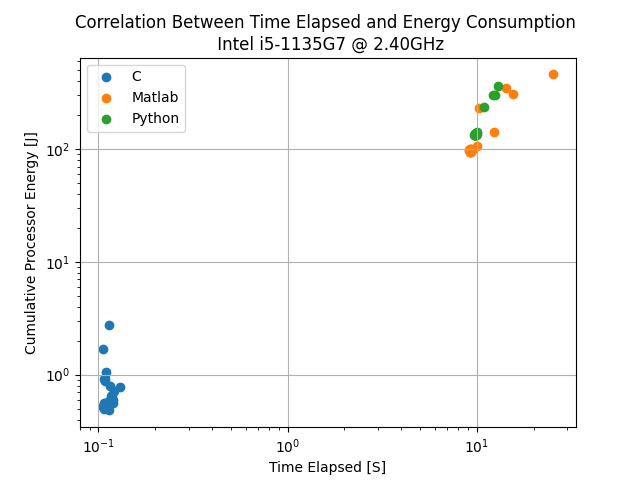 []{#fig:post
label=”fig:post”}
[]{#fig:post
label=”fig:post”}
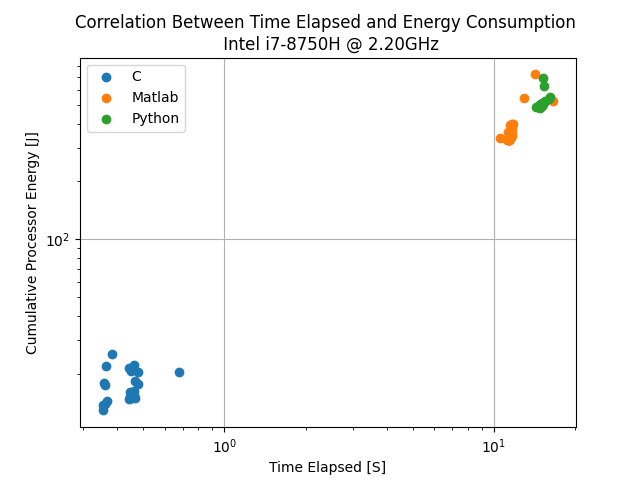 []{#fig:post label=”fig:post”}
[]{#fig:post label=”fig:post”}
 []{#fig:pre label=”fig:pre”}
[]{#fig:pre label=”fig:pre”}
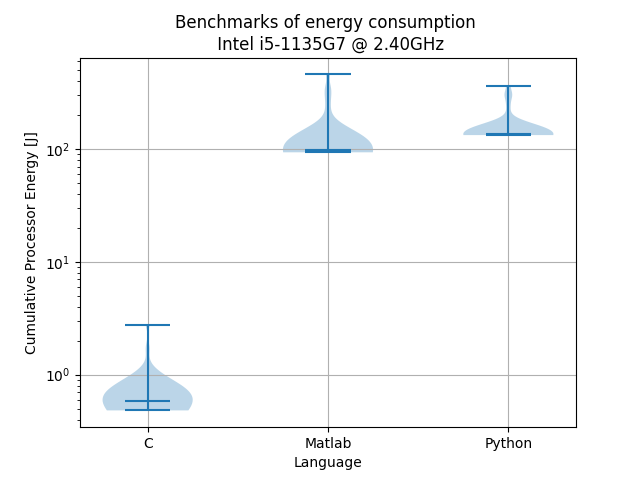 []{#fig:post label=”fig:post”}
[]{#fig:post label=”fig:post”}
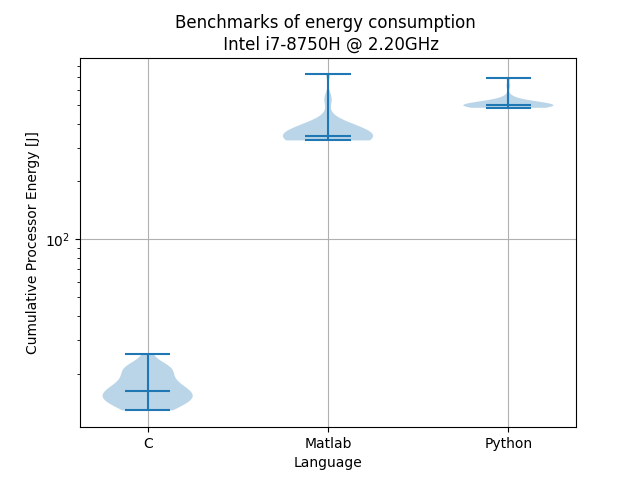 []{#fig:post label=”fig:post”}
[]{#fig:post label=”fig:post”}
Results
In this section we will analyze the results. The code is run on three computers, with each language running 30 times. The code is then plotted on two axes with time and energy consumption as the measurements. The three languages used are C, Matlab, and Python. C is a compiled imperative language, while Matlab and Python are interpreted languages.
RQ1. How does the energy consumption of each programming language compare? {#rq1.-how-does-the-energy-consumption-of-each-programming-language-compare .unnumbered}
Comparing the results tells us that C is faster than Matlab, which in turn is faster than Python. One interesting finding is that there are significant differences in energy consumption, depending on what CPU is used, however C was consistently much more efficient than the other two. Since C is a compiled language, it makes sense it’s the fastest. C was build for speed, and to run on embedded devices with very limited computing power. It also provides tools for developers to effectively manage their programs threads, and storage by programmatically allocating the needed storage. By lowering the abstraction level C programs becomes harder to write and maintain, but when it comes to execution measurements it’s superior to the other languages. The task chosen for each language to perform is also a task typically performed by C. It’s a scientific computing task, often performed on an embedded device, which is where C thrives.
Matlab and Python both suffer from the same structural problem. They are both interpreted languages, and have several abstraction layers more build on than C has, and that comes with a cost. By having interpreter interpret the code line by line, and then run it there’s a lot of overhead computing cost that C simply does not have. This results in a lot of energy consumed, that means the energy consummation is magnitudes higher then that of C.
RQ2. How does the energy consumption on average differ inside each programming language? {#rq2.-how-does-the-energy-consumption-on-average-differ-inside-each-programming-language .unnumbered}
The different samples of C use quite a big percent wise change when it comes to energy. The median usage is around 0.3 joule, with a big outlier at around 2 joules. The data is nicely distributed about the mean, and the amount of samples with higher energy usage falls quickly, with a few outliers.
The same can be observed for Matlab and Python. The median value is close to the lowest observed value but the frequency of observations at the higher intervals decreases rapidly, until it reaches a couple of outliers. From the violin plots we can tell the variance is not very big around the mean and the lowest observed value, but the percentage wise variance is not as big as it is for C.
Some of the tests have outliers when it comes to the maximum observed energy consumption. This might be caused by the computers not fully being in "zen-mode". The outliers can be categorized as background tasks or other things that wasn’t disabled properly. There is only one outlier pr language pr test, which further strengthens the hypothesis that it’s noise effecting the test results. But in figure 6 the Matlab outlier requires quite a lot more energy than the outlier for C, so there might be some runs where a run requires more power. It could also be because the order of which the tests were executed were not favourable for this specific test.
Discussion
Comparing our results
Comparing our results with the results of the study “What Are Your Programming Language’s Energy-Delay Implications?”. In the paper they compare multiple languages on multiple different use cases. The two use cases that comes closest to the use case presented in our paper is the arithmetic operations and sorting algorithms. In both of these use cases the C code is magnitudes faster than the python code, which corroborates the results presented in this paper. The unit used in the paper is not that same as used in this paper. They use EDP which is designed to penalize slow runs. In this paper only time and energy consumption is used, but we don’t have to further penalize slow runs to be able to compare the results of the paper.
From this study and “What Are Your Programming Language’s Energy-Delay Implications?” it seems that the best option when choosing a programming language would always be C, however this is not necessarily the case. The reason for this is the fundamental difference in which these languages work. C is a compiled language and will therefore in almost all cases be faster, however this makes it more difficult to use in general as it requires a very specific syntax. Matlab and Python are both interpretative languages this makes much slower since the program reads line by line, however the syntax is easier since it’s closer the English language.
Limitations
Comparing the languages using only one use case has it’s limitations. Programming languages are optimized for different use cases, and the use case in this paper is mostly fit for C. The languages chosen are mostly used for handling data, but Python is usually used in this use case as an interface to C libraries. This makes it easier to write for the developers, and still maintains the speed. The implementation of the Python program uses numpy to sort the array, and plain python to compare the distance between the points. Therefore the difference in speed between Python and C is mainly based on the comparison of the points, and not the actual sorting. But the sorting doesn’t take a lot of time compared to the comparisons, so most of the time consumed is spent comparing the points.
The study is run on three laptops using different Intel CPU’s with different speeds. For the study to properly compare the energy usage of these languages we would have to test on a lot more CPU’s, and as mentioned earlier a lot more use cases. Computer architectures are implemented differently and the results of the tests would depend on the architecture of the computer. For this study to yield any real results, a lot more use cases and hardware would have to be introduced. Then software engineers would be able to consult this study, and make decisions based on how often they would have to run the program, the hardware available and the use case of the user.
The implementations of the use case would also have to share some similarities. Since the same code can’t run in all the different languages, the implementations would have to be as similar as possible, and be optimized for the same metrics.
The program used to record the energy consumption was Intel Power Gadget 3.6. Using a software to find energy consumption has numerous issues. Having to run the software along with program for which you want to measure energy consumption can lead to an increase in measured consumption, this is particularly bad for small programs which needs very little energy to run. Furthermore the precision in general can be called into question, since this tool only measures energy consumption in the processor.
In a lot of out experiments throughout testing Matlab usually had one outlier which was up to three times slower than any other measurement. This can be seen on the measurement with the Intel i5-6200 CPU. Looking into this we found that it was most often the first measurement and we hypothesise that this is due to time used connection to the interpreter.
Conclusion
This study compares three languages but is not exhaustive. The size of the study introduces problems when it comes to getting an actual representative view of the languages. The study can be consulted as a quick comparison of energy consumption if the goal is to do scientific computation.
The Limitation of the study can be summarized in three points. The use case of the specific code is important since different languages are optimized for different things. Therefore one needs to think about this when choosing language. The computer architecture/hardware, it is clear from the results that this have a huge impact on how fast the program was and how much energy it consumed. Lastly since the program used to measure energy consumption only measures in the processor this accuracy can be called into question.
From this study we recommend that C should be used in cases where this is possible. If another language is chosen for reasons not only concerned with energy consumption we recommend the use of libraries that uses C in some way like for instance NumPy.
Appendix {#appendix .unnumbered}
The code used for this project is stored here:
https://github.com/eliasstenhede/sustainable_software_engineering.